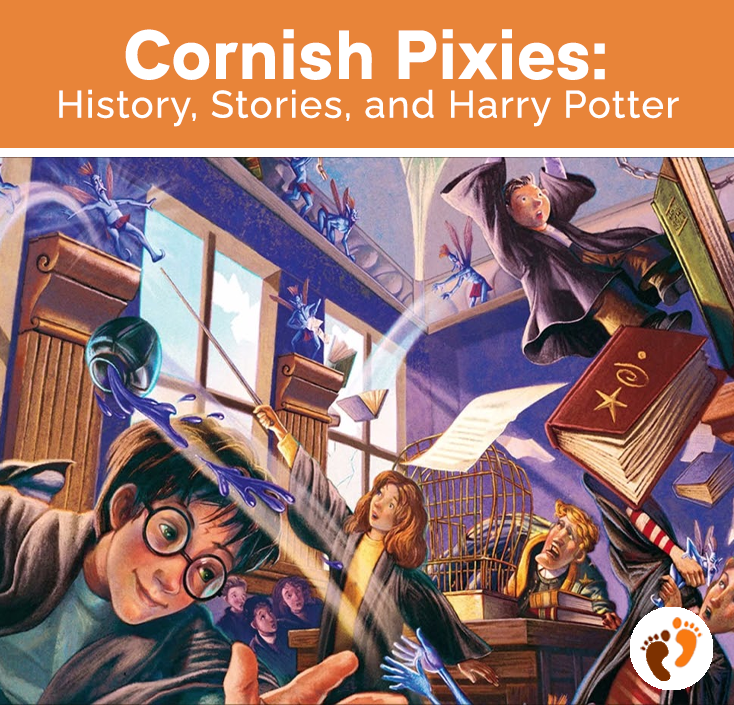
By
Editor
Updated on
When people think of Cornwall, it generally conjures up images of golden, sandy beaches, long, rugged coastlines, and delicious Cornish pasties.
But what many people may not know is that Cornwall is also associated with many legends and myths. Some of these, such as those relating to King Arthur, are more well-known than others. And many of these include mythical creatures, such as bluecaps, buccas, knockers, and of course, pixies.
Pixies are perhaps the most famous of all these creatures, finding a mention in pop culture icons like Harry Potter and Disney’s Peter Pan. This guide aims to shed some light on the origin and history of these creatures and some of the tales associated with them.

Pixies In Cornish Folklore
While pixies are pretty common in British folklore, Cornish pixies are unique in their appearance, traits, and behaviour. They are sometimes confused with fairies, which are more common in the folklore of neighbouring countries, like Ireland but are not the same.
In most depictions, fairies resemble tiny human beings closely but have wings, while pixies are even smaller and have coloured skin. According to legend, these fairy-like creatures tend to have a very mischievous nature and are known to cause travellers to lose their way.
But despite their prankish and fun-loving nature, pixies were sometimes said to help with housework. With time, the tales and stories surrounding these creatures evolved, and they started being associated with good luck. Many households even used to have charms for attracting pixies for good luck.
Origin And History
There are several stories regarding the origin of pixies. Some state that these creatures had been the souls of pagans, while others state they were the souls of babies who had never been christened. However, it is understood that pixies were a part of Cornish folklore much before Christianity became popular in the region.
They only became a part of Christian folklore later on, and were supposed to be souls who could neither enter heaven nor hell, hence were stuck in between. Pixies are known by many names in Cornwall, such as piskies, pigsies, and pizkies.
Most legends agree that pixies were generally common on the moorlands of Cornwall and Devon and resided underground in barrows or stone circles.
General Appearance And Behaviour In Cornish Folklore
Traditionally, pixies have an elf-like appearance and are similar in size to small children. They are generally said to be wearing green outfits and may have red hair or red caps and pointed ears. But this depiction only became popular in the Victorian era and was not a part of the original mythology of these creatures.
In earlier stories, they were said to wear dirty rags, which they would discard when given new clothes. While local folklore puts emphasis on the mischievous nature of pixies, according to most stories, these tiny creatures did not harm humans. In fact, some, such as the legendary queen of the pixies, Joan the Wad, were considered signs of good luck.
Similarly, the king of the pixies, Jack o’the Lantern, could help improve one’s fortune, though, in some tales, he was responsible for leading travellers astray. Cornish folklore also states that pixies were very fond of dancing and often wrestled and danced throughout the night.
One reason for their leading people astray was said to be so that they could join the pixies in their games and dancing.
Stories And Tales About Cornish Pixies
There are several stories about Cornish pixies, most based on their penchant for mischief and tricks. A popular one is about a little boy from St. Allen, near Truro, who went to collect flowers in a valley near his home. When he did not return for some time, the villagers went to look for him but could not find any sign of him.
On the third day of the search, the boy was found unharmed and fast asleep in the same location where he had been last seen. Upon waking up, the boy could not remember having been lost. He could only recall following the sound of a beautiful song into the woods when night fell suddenly, and he was surrounded by several stars.
But these were not stars but were, in fact, pixies who led him to a cave that contained many wonderful treasures and gave him honey to eat. After that, they sang him to sleep, and when he woke, he was back where the villagers had found him.
In other folktales, pixies appeared at the doors of farmhouses and, due to their childlike appearance, were taken in and pampered. After enjoying such treatment, they would often vanish without a trace, never to be found again. Sometimes, they would even exchange ugly babies with beautiful infants. This was generally associated with the Changeling pixies of West Cornwall.
Cornish Pixies In Harry Potter
In the Harry Potter series, Cornish pixies are depicted as small creatures with insect-like bodies and bright, electric blue skin and wings. Unlike older depictions, these pixies had the ability to fly but shared the same liking for mischief. And when let loose in a classroom, they proceed to wreak havoc on their surroundings with great joy.
According to some people, the blue colour of these pixies was based on a legend according to which pixies were the last remaining members of the Pict tribes of Cornwall. It is said that these tribes used to paint their skin blue using woad, a native flowering plant.
Conclusion
Pixies are among the oldest creatures in Cornish folklore, which is why there are so many variations of them. They are also one of the most iconic symbols associated with Cornwall, much like the legendary King Arthur. Even today, you can find many shops selling pixie-shaped charms and souvenirs in the area.
About The Author

Reviewed by
Editor
Related Posts
[wp post shortcode here]

